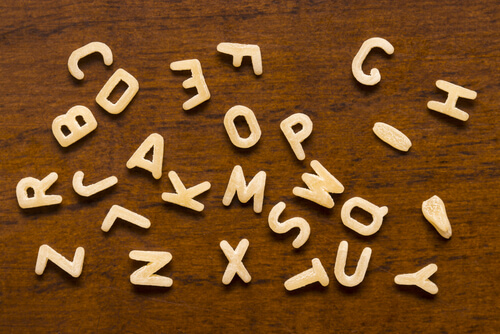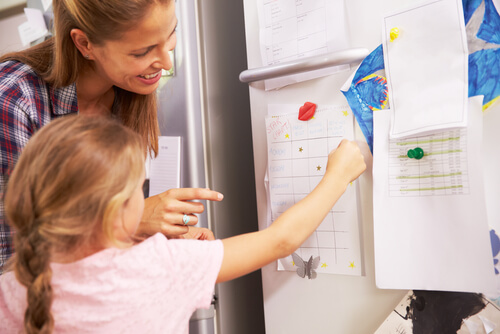7 Exercises for Learning to Read

Exercises for learning to read are a great way to give your child a good start with their education.
These fun games will keep kids entertained and focused. Before you know it, their reading skills will greatly improve.
Learning to read is a long process, and can be both exciting and frustrating. For parents, patience is fundamental.
Moms and dads play an important role in helping children develop this key skill. With a little bit of creativity and a lot of time, you’ll be able to help your child learn to read.
If inspiration is what you need, here are 7 fun exercises for learning to read, all of which are sure to be a hit with your little one.
7 exercises for learning to read
1. Sound flashcards
The first exercise is very simple. All you need is to make flashcards with different syllables and letter sounds. Your child’s task is to make words out of the sounds they choose.
To add an element of fun, put the flashcards into a basket and let your child choose one.
When they’ve picked a sound, you should say it out loud. Then wait and see what your child’s imagination can come up with.

2. Alphabet soup
Alphabet soup or spaghetti is a fun activity for children who are learning to read. You could ask your child to find the vowels or consonants among all the letters in front of them.
You could also cut out paper letters for your child to color in, to enrich the learning experience.
Having fun helps children to learn. If they see an activity as a game, they’ll get more out of it.
3. Build a word
This exercise is a little more demanding for your little one. Write down the letters of the alphabet on small pieces of paper and cut them out, making sure each piece is the same size.
Next, spread the pieces of paper out on the table, within your child’s reach. You could start by asking your child to point to the letters as you say them.
Once your child has begun learning to read and write, invite them to choose the letters and use them to make whole words. This is one of the most practical exercises for learning to read.
4. Word flashcards
This tends to be one of the most effective exercises for learning to read.
In this case, make flashcards with words on them. You can write them out by hand or use the computer, but make sure the letters are large, clear and rounded.
To make the exercise easier, make groups of similar words.
Every week, add new words to your flashcard collection. Sit in front of your child and show them the cards as fast as you can.
At first, you might need to tell them what is on each card. Over time, your child will learn to identify the words on the flashcards. You can also bring pictures into this game.
Words and pictures
Images are a great way to help your child learn to identify new words. In this case, you can use them in a game to help your child learn the vowel sounds.
The first step is to prepare 5 baskets or bowls to represent each of the 5 vowel sounds. Next, print images of different animals or objects that start with each sound.
Take a printed picture, and ask your child to name the animal or object. Next, your child should decide which vowel group the word fits into.
6. Sticky labels
This activity involves labelling objects and parts of the house with sticky notes. Make sure each label is in a place where your child can see it.
This way, every time they pass the note, they’ll associate the object or room with the correct word.
Later, you can remove the labels and see whether your child is able to put each one back in the right place.
If you want to add a level of challenge, you could try tricking your child by putting the label in the wrong place.
If the game is too difficult, add images along with the words.
This is a fun way for your child to learn and will motivate them to keep trying.

7. Reading together
Last but not least, remember to read with your child. Although it may seem obvious, this is one of the best ways to help them learn.
Shared reading time benefits cognitive development and language acquisition.
Story time builds your child’s vocabulary and pre-reading skills, and nurtures their imagination.
What’s more, reading books together is a great way for parents and children to bond.
All cited sources were thoroughly reviewed by our team to ensure their quality, reliability, currency, and validity. The bibliography of this article was considered reliable and of academic or scientific accuracy.
- Parra Bravo, P. & Bojorque, G. (2021). Desarrollo de la conciencia fonológica en edades tempranas: Revisión de la literatura. Pucara, 1(32), 139–160. https://publicaciones.ucuenca.edu.ec/ojs/index.php/pucara/article/view/3973
- De la Calle Cabrera, A. M., Guzmán-Simón, F., & García-Jiménez, E. (2019). Los precursores cognitivos tempranos de la lectura inicial: un modelo de aprendizaje en niños de 6 a 8 años. Revista de Investigación Educativa, 37(2), 345–361. https://revistas.um.es/rie/article/view/312661
- Holguín González, M., & Zambrano Cedeño, E. (2021). El trabalenguas como estrategia para desarrollar la fluidez verbal en Educación Básica Elemental. Revista Cognosis, 6(1), 69–80. https://revistas.utm.edu.ec/index.php/Cognosis/article/view/3344
- Gutiérrez-Fresneda, R., de Vicente Yagüe Jara, M. I. & Alarcón Postigo, R. (2020). Desarrollo de la conciencia fonológica en el inicio del proceso de aprendizaje de la lectura. Revista Signos, 53(104), 664–681. https://dialnet.unirioja.es/servlet/articulo?codigo=7702921
- Lema Ruíz, R. A., Tenezaca Romero, R. E., & Aguirre Gallegos, S. Y. (2019). El aprestamiento a la lectoescritura en la educación preescolar. Revista Conrado, 15(66), 244–252. https://conrado.ucf.edu.cu/index.php/conrado/article/view/905
- Larraniaga López, M. L., & Bejarano Chamorro, J. A. (2022). La lectura y escritura emergente en niños y niñas a través del cuento. Revista Criterios, 29(2), 57–75. https://revistas.umariana.edu.co/index.php/Criterios/article/view/3051
- Murillo, M. (2019). El desarrollo de la conciencia fonológica: una propuesta para la cotidianeidad del aula. Revista Electrónica Leer, Escribir y Descubrir, 1(5), 9–25. https://digitalcommons.fiu.edu/led/vol1/iss5/2/
This text is provided for informational purposes only and does not replace consultation with a professional. If in doubt, consult your specialist.
